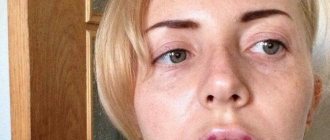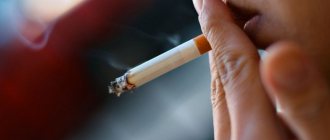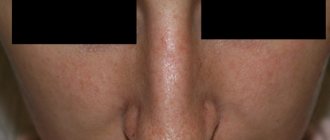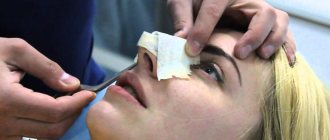Why does the tip of the nose and other areas swell?
Swelling is a natural reaction of the body after any surgery.
When tissue is damaged, the vascular endoderm is damaged. The blood that is in them flows into the tissues, causing swelling and hematomas. During rhinoplasty, swelling primarily affects the nasal cavity , mucous membrane, as well as the paranasal surface - cheeks, chin.
In this regard, nasal breathing may be difficult or absent, hematomas and swelling of the face may appear, the process is accompanied by pain. The intensity of edema depends on the physiological structure of the person and the complexity of the operation. For some, it may be minimal after surgery, for others it may be intense, to the point of swelling of both eyes.
general description
According to aesthetic standards, the wings of the nose should not protrude beyond parallel lines drawn from the beginning of the eyebrows to the mouth.
A wide nose may be a genetic feature that is associated with the ethnic specificity of the structure of the soft tissues of the face.
It is characterized by rounded shapes without obvious relief; large nostrils; the lateral crura of the cartilages are convex; soft tissues have excess thickness.
Organ deformation can be caused by post-traumatic and other complications - due to careless physical actions, the development of tumors, or a progressive infectious process.
In rare cases, the cause of the pathology is birth defects, abnormal structure or diseases.
To correct the problem, rhinoplasty is performed. Usually they affect cartilage, but it is also possible to intervene in bone structures.
The operation requires a longer rehabilitation period.
Efficiency
Rhinoplasty allows you to individually calculate the proportions, location of incisions and punctures.
The specifics of the defect involve the following manipulations:
- Hypertrophied nostrils, massive tip - truncation of excess cartilage and soft tissue.
- Flattened, flat back - implantation of your own cartilage or synthetic material.
- Wide bridge of the nose - rhinoplasty with osteotomy.
Adjustment involves more than just working on form. If necessary, it is also aimed at the landing height.
To achieve the result, narrowing the nostrils, modeling and changing the size of the wings is combined with raising the bridge of the nose and other manipulations.
Efficiency is assessed based on the following criteria:
- the width of the nose corresponds to the proportions of the face;
- the organ is freed from excess tissue that gives volume;
- the scar is not noticeable.
Photo
Next, you can see in the photo what the swollen tip of the nose and paranasal areas look like after surgery.
Precautionary measures
Aesthetic rhinoplasty is a serious operation that must be performed by an experienced surgeon.
A thorough analysis of the condition of the nose and the position of the wings is necessary for a high-quality and safe result. Otherwise, deformation may occur and the tissue will lose functionality.
The result of the work can be assessed in different projections - from above, from below and from the sides. To prevent the suture from being visible, its width should not exceed 0.4 cm. This can only be done by a specialist with microsurgical skills.
Side effects:
- prolonged nasal congestion;
- labored breathing;
- severe swelling;
- profuse nosebleeds;
- chronic runny nose;
- pronounced scars;
- tissue necrosis;
- wound infection;
- asymmetry of the nasal passages;
- the appearance of a vascular network;
- intracranial complications;
- numbness of the skin.
How long does the swelling last and when does it go away?
Many people thinking about rhinoplasty are concerned with the question: how long does it take for swelling to subside and when can you completely get rid of it? On average, complete rehabilitation after surgery takes about a year. The process may proceed faster or a little longer, depending on the physiological structure of the patient.
The formation and resorption of edema can be divided into several stages. In each of them, the severity of edema will be different.
- First week after surgery. This is a difficult time for the patient.
Swelling begins to form already on the operating table, and will increase for another one or two days after. Visually, it is clearly expressed in swelling of the tip of the nose and paranasal areas, hematomas. To maintain the shape of the nose after surgery, special bandages are applied - splints. Because of them, swelling and hematomas can be observed not so much on the nose itself, but on the cheeks and chin. In addition, to stop bleeding, bandage ducts are inserted into the nose, which makes nasal breathing impossible. In addition to swelling, the patient is characterized by pain and bleeding. Over the course of several days, the splints and trunds are removed. - Second - third week after surgery. The patient feels much better, the pain goes away, swelling and bruising gradually disappear. What remains is secondary edema, a thickening of tissue in the nasal cavity, expressed in swollen wings and the tip of the nose.
During this period, you can already return to communicating with people, to everyday activities, and moderate physical activity.Periodic nasal congestion and discharge mixed with blood is a normal condition; there is no need to worry about this.
- 2 and third months after surgery. Visible traces of edema completely disappear, nasal breathing is restored, but complete tissue restoration has not yet been completed. There are small seals on the tip of the nose and a lack of sensitivity. But by this time you can already draw a conclusion about the result, evaluate the shape of the nose, and admire the result.
- The final stage can last up to a year. Swelling is practically not felt by the patient himself and is not noticeable to the environment. It appears only in small compactions of individual, mostly internal parts of the nose. By this time, the patient can fully return to his usual lifestyle.
Now you know how long it takes for swelling to go away after surgery.
The essence of the method
The nose may look wide due to the disproportion of its back, nostrils or wings. Sometimes all these parts require correction. During rhinoplasty, part of the cartilage is removed, and the remaining parts of it are brought closer together and connected.
If the nose is wide due to bone characteristics, an osteotomy is performed. And then they are given a new position to make the nose look thinner. Sometimes grafts are used for this purpose, with the help of which the height of the back is increased. The nose thus visually narrows.
Wide nose correction option
How to quickly reduce and remove swelling?
Next, we’ll talk about how to quickly remove swelling from the nose and get rid of swelling on the face if it does not go away for a long time.
General Tips
There are a number of recommendations on what to do to make swelling go away faster after surgery:
- The best way to quickly relieve swelling is cold compresses. For this, ice cubes wrapped in cloth and applied to the swollen paranasal areas may be suitable.
- Hot baths, saunas and baths are strictly contraindicated. Such procedures increase blood flow to swollen tissues, thereby aggravating the process. In the first stages after surgery, it is recommended to sleep half-sitting, on a high pillow or with the head of the bed raised.
- Avoid high physical activity, especially associated with prolonged tilting of the body or head. But you shouldn’t give up movement completely. Light walks and exercise in the second to third week after surgery will have a beneficial effect on swelling reduction and recovery.
- The diet is moderate, you should avoid heavy consumption of spicy, salty foods.
During the rehabilitation period, it is better to completely abstain from alcohol and nicotine.
By reading special publications on our website, you can also find out the following information:
- What are the stages of rhinoplasty and what are the possible consequences?
- What techniques are used for plastic surgery of the wings, tip and other parts of the nose?
- How to fix a nose with a “potato” and how is surgery performed on the tip of the nose?
- What is non-surgical rhinoplasty and how is the procedure performed using threads?
- What can be considered a failed rhinoplasty?
Preparations and ointments
- As a rule, the temperature remains within 38 degrees for several days after surgery. Patients are prescribed antibiotics. Painkillers are used to relieve pain.
- When obvious signs of bleeding disappear, the doctor may prescribe decongestant ointments and gels, such as troxevasic ointment, Traumeel, Bodyaga.
- Among the drugs taken orally, Bromelain, an extract from pineapple that relieves inflammation and swelling, has proven itself well.
- “Dimexide” is used as compresses by diluting the preparation with water.
- To help the residual swelling of the tip of the nose go away faster, use “Diprospan” as an injection into the area of swelling. The procedure is not so simple and quite painful, so it must be prescribed and performed by the doctor himself.
- Also, throughout the entire rehabilitation period, it is recommended to use sprays and drops with sea water Aqualor, Aquamaris. They rinse the nose from accumulated secretions and help the healing process of the intranasal cavities.
Folk remedies
The use of folk remedies is no less effective in relieving swelling.
- The first place on the list is taken by a cut aloe leaf, which the patient applies to the areas of swelling.
- Compresses made from a decoction of chamomile and string help well.
- You can brew and drink dry arnica tea.
Preparing for surgery
Before the intervention, the patient undergoes a preliminary stage. Necessary:
- take general blood and urine tests, a coagulogram, for infections, do an ECG, fluorography, X-ray, CT scan of the nasal sinuses;
CT scan of the sinuses
- get advice from a therapist, otorhinolaryngologist, surgeon and anesthesiologist;
- 2 weeks before plastic surgery, stop smoking and alcohol, taking blood thinning medications and staying under ultraviolet rays;
- Eat a light meal the day before and do not have breakfast on the day of surgery.
Opinion of cosmetologists
Wide nose rhinoplasty is considered an effective procedure.
Experts recommend correcting imperfections using the traditional surgical method, since there are currently no alternative effective options:
Reviews
Zhanna, 30 years old
I want to leave a candid review about how my rehabilitation went after my nose job. I had rhinoplasty done at a fairly famous clinic in Moscow. I don't want to advertise to anyone. The essence of the operation is to remove my long tip of the nose. The preparation went quickly enough, but after the operation it was just terrible. Swelling, as if I was being hit by a crowd of people, and in the face at the same time. I thought I was going to faint when I looked in the mirror the next day. And everything around my nose hurt a lot. A swollen nose after rhinoplasty is not a sight for the faint of heart. I started a scandal, maybe I haven’t recovered from the anesthesia yet. I had a complete feeling that everything had gone wrong. The doctor tried her best to calm me down, saying that swelling after surgery is a common occurrence, and she warned me about it. I was offered a drug that would help reduce the pain. I agreed. And Diprospan helped me with the swelling, she injected me with it personally, and it became easier in just 3 days. The swelling on my face completely disappeared in about a month.
Answers to basic questions
Will the operation be easier if the patient's skin is thick or thin?
The wide tip is difficult to operate on thin skin. This is the competence of a highly qualified surgeon with extensive experience. In this case, accurate preliminary calculations, jewelry finesse and extreme caution are important. With a thin one, it’s easier to reduce the size, add elegance, but not do the main work.
Thick skin does not guarantee that the nose will become expressive and sophisticated. Dense tissue is prone to scarring, so corrective plastic surgery is often needed afterwards.
Is it possible to make a correction without surgery?
A non-surgical injection method can provide the missing volume in areas where it is needed and remove the hump. An organ can be corrected only in case of asymmetry. But it will not become narrow, but only symmetrical, since the smaller side will increase in accordance with the wide one.
Another option is injections of hormones - glucocorticosteroids, which soften and partially break down the cartilage tissue. This allows you to correct the nose manually, eliminating many defects. After the injection, a special splint is fixed, compressing the desired areas.
Physiotherapy after rhinoplasty
This type of procedure is prescribed by a doctor and helps to heal postoperative wounds and relieve swelling. The most common physical procedures after rhinoplasty:
- Phototherapy . This procedure is carried out using a special device that generates light waves of ultraviolet and infrared light. This manipulation has a positive effect on blood flow, promotes the removal of decay products, reduces swelling, and removes hematomas;
- Microcurrents . In this case, a low voltage current is applied to the swollen area. Before carrying out the manipulation, it is necessary to apply a special gel, which will speed up the metabolic process of cells and help reduce swelling.
- Phonophoresis . This modern device allows drugs applied to the problem area to penetrate deeply into the skin using ultrasonic action. This safe and painless procedure can significantly speed up the recovery process. Several treatments will be required to obtain the full effect.
At the end of the article, we invite you to read reviews from patients about rhinoplasty, where they will share tips on how to cope with swelling after rhinoplasty
What to do if the result is not what was expected?
If the patient is dissatisfied with the result, he should contact a plastic surgeon . After the consultation, it will become clear whether a repeat operation is needed, or whether other corrective procedures can be used. In any case, it is worth remembering that surgery is a risk.
The decision to undergo rhinoplasty is always made by the patient. When choosing a nose job, you should do your research carefully and then find a professional in plastic surgery.
What is considered a failed rhinoplasty and what to do in this case, we tell you in a separate article.











